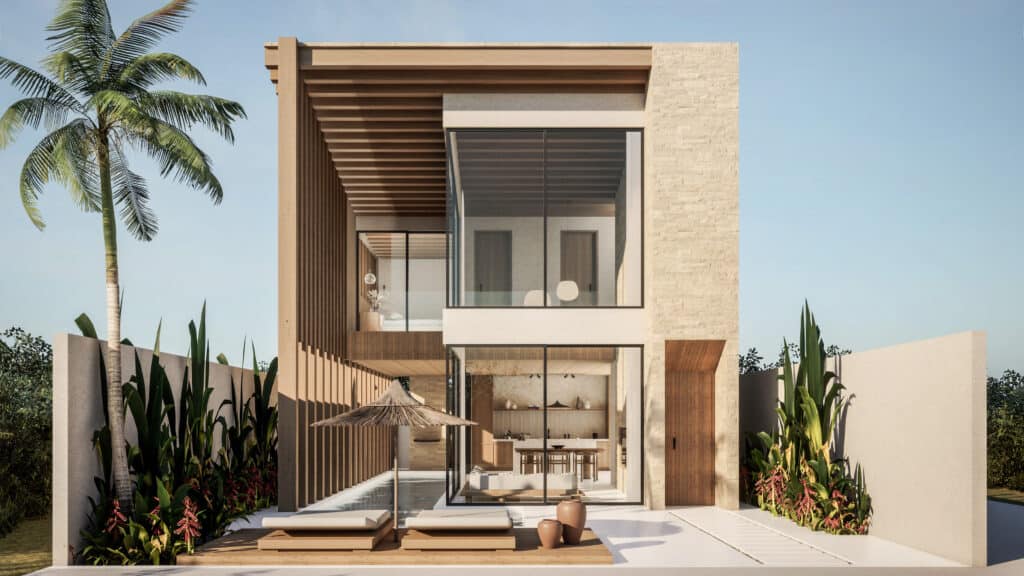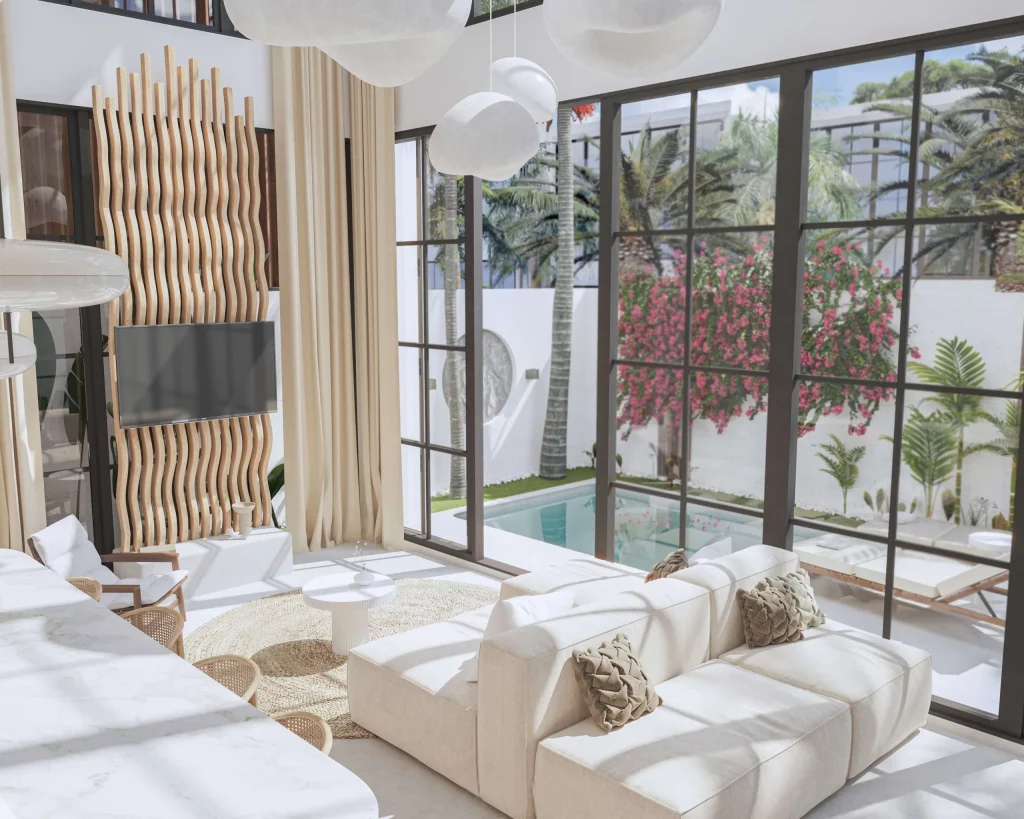As Bali continues to attract foreign investors and homebuyers, understanding the latest villa design trends is essential for making informed decisions. This tropical paradise offers a unique blend of architectural styles, catering to diverse tastes and preferences. Whether you’re looking to build your dream villa or purchase a property, exploring the current design trends—from traditional Balinese aesthetics to Mediterranean inspirations—can help you find the perfect fit for your lifestyle. Join us as we delve into the stunning villa styles that are defining Bali’s real estate landscape.
Traditional Balinese Design
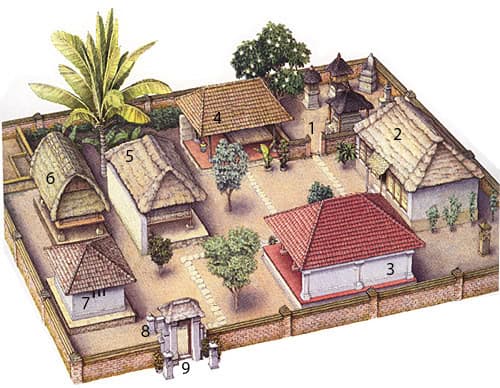
The uniqueness of traditional Balinese house design lies in the separation of each room. You can often find this layout in the homes of local people. However, with the rise of villas catering to foreigners, modern traditional designs have emerged. These designs maintain the separation of areas such as the living room and kitchen while incorporating modern style elements for a more contemporary feel.
Traditional Balinese architecture is a harmonious blend of spirituality, nature, and craftsmanship, reflecting the island’s rich cultural heritage. Key features include:
- Open Layouts: Traditional villas are designed with open-concept living spaces that allow for natural airflow and light, creating a seamless connection between indoor and outdoor environments. This design not only enhances comfort but also embodies the Balinese philosophy of living in harmony with nature.
- Natural Materials: Emphasizing sustainability, traditional Balinese villas often utilize locally sourced materials such as bamboo, teak wood, and natural stone. These elements not only contribute to the aesthetic appeal but also promote environmental consciousness.
- Thatched Roofs: The iconic alang-alang (thatch) roofs are a hallmark of Balinese architecture, providing both shelter and insulation from the tropical heat. This traditional roofing technique also adds an element of authenticity to the villa’s design.
- Spiritual Elements: Many traditional villas incorporate shrines and intricate carvings that reflect the deep spiritual beliefs of the Balinese people. These features not only enhance the aesthetic value but also serve as a reminder of the island’s rich cultural traditions.
Unique Fact #1: Traditional Balinese architecture is heavily influenced by the concept of “Tri Hita Karana,” which emphasizes harmony among humans, nature, and the spiritual realm. These villas often feature separate pavilions for living, sleeping, and dining areas, connected by covered walkways.
Modern Balinese Design
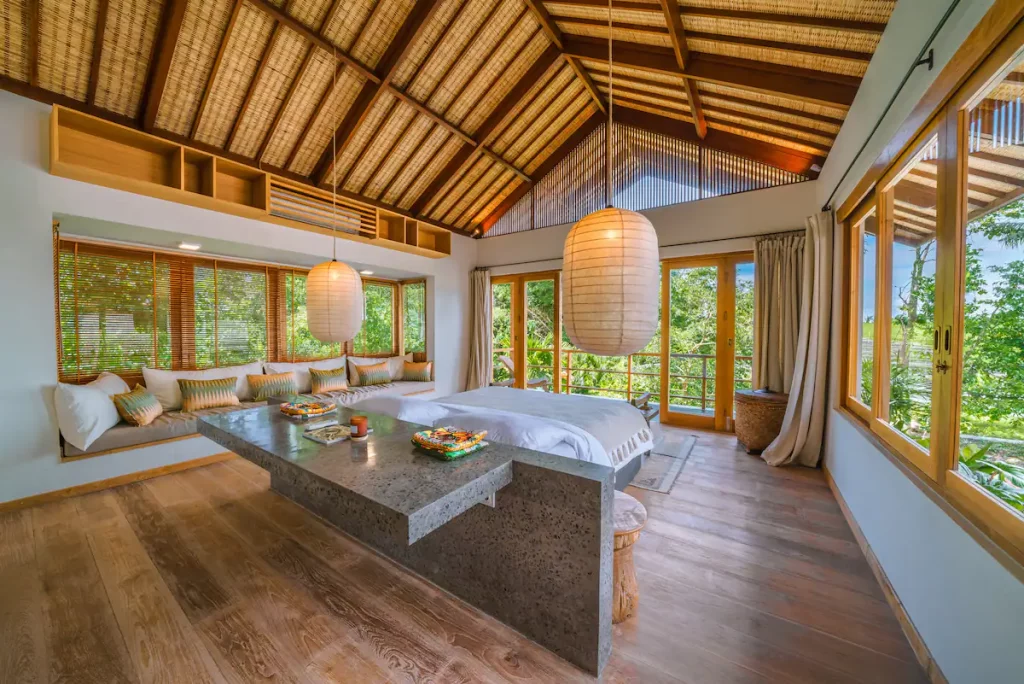
Modern Balinese architecture takes the essence of traditional designs and infuses them with contemporary elements, creating a stylish and functional living space. This approach appeals to many foreign investors and homeowners who seek comfort without sacrificing cultural authenticity. Key features include:
- Sleek Lines and Minimalism: Modern Balinese villas prioritize clean lines and a minimalist aesthetic, often incorporating geometric shapes and open spaces. This design philosophy creates a sense of sophistication and tranquility, allowing the natural beauty of Bali to take center stage.
- Eco-Friendly Features: With an increasing emphasis on sustainability, many modern villas include eco-friendly elements such as solar panels, rainwater harvesting systems, and energy-efficient appliances. This commitment to sustainability not only reduces environmental impact but also lowers long-term living costs.
- Indoor-Outdoor Flow: Expansive glass doors and large windows are common in modern Balinese designs, allowing for seamless transitions between indoor living areas and lush outdoor spaces. This creates a harmonious connection with nature and enhances the overall living experience.
- Contemporary Decor: Modern Balinese villas often feature contemporary furnishings and decor, blending traditional craftsmanship with modern design. This fusion results in inviting spaces that reflect both local culture and global trends.
Unique Fact: The concept of “open living” is a hallmark of modern Balinese design, encouraging residents to embrace the island’s tropical climate. Many villas include outdoor lounges, kitchens, and dining areas, allowing for year-round enjoyment of Bali’s natural beauty and vibrant atmosphere. This design trend not only enhances the living experience but also fosters a strong connection with the surrounding environment.
Mediterranean-Inspired Villas
In recent years, Mediterranean-inspired villa designs have gained popularity in Bali. We think because it’s 100% looks good on Instagram Reel or TikTok. This trend combines the laid-back luxury of the Mediterranean with Bali’s tropical setting.
- Whitewashed Exteriors: Characterized by stucco walls and terracotta roofs, Mediterranean-inspired villas often feature whitewashed exteriors that reflect sunlight and create a bright, airy atmosphere. This classic look is both timeless and inviting.
- Arched Doorways and Windows: Arched doorways and windows are a staple of Mediterranean architecture, adding elegance and sophistication. These architectural details not only enhance the aesthetic appeal but also allow for plenty of natural light to flow into the living spaces.
- Lush Courtyards and Gardens: Many Mediterranean villas incorporate lush gardens and private courtyards filled with fragrant plants, providing a tranquil retreat that mimics the peaceful ambiance of coastal living. These outdoor spaces are perfect for relaxation and social gatherings.
- Terraces with Ocean Views: Emphasizing outdoor living, Mediterranean-inspired designs often feature spacious terraces and balconies that offer stunning ocean views. These areas serve as ideal spots for entertaining guests or enjoying a quiet moment while taking in the beautiful surroundings.
Unique Fact: Mediterranean-inspired villas often incorporate elements like clay tiles, wrought iron accents, and intricate mosaics, which are reminiscent of coastal towns in Southern Europe. This combination of styles creates a unique fusion that reflects both the rich cultural heritage of the Mediterranean and the natural beauty of Bali, making these villas a popular choice for those seeking a luxurious yet laid-back lifestyle.
Contemporary Luxury Villa Design
Contemporary luxury villas in Bali epitomize modern elegance, offering high-end design and amenities that cater to discerning buyers seeking a lavish lifestyle. This architectural style integrates cutting-edge design with comfort and sophistication. Key features include:
- Open-Concept Layouts: Contemporary luxury villas often feature expansive open-concept living spaces that create a sense of flow and openness. Large, airy rooms are designed to maximize space and light, providing an inviting atmosphere for both relaxation and entertaining.
- High-End Finishes and Technology: These villas typically boast premium materials such as marble, hardwood, and glass, complemented by state-of-the-art appliances and smart home technology. This attention to detail not only enhances comfort but also elevates the overall living experience.
- Infinity Pools and Outdoor Entertainment Areas: A hallmark of contemporary luxury design is the inclusion of stunning infinity pools that blend seamlessly with the surrounding landscape. Outdoor entertainment areas, complete with lounges, kitchens, and fire pits, offer the perfect setting for hosting gatherings or enjoying tranquil evenings.
- Sustainable Design Elements: Many contemporary luxury villas incorporate eco-friendly features, such as energy-efficient systems, sustainable building materials, and green roofs. This commitment to sustainability not only benefits the environment but also appeals to buyers looking for responsible investment options.
Unique Fact: Contemporary luxury villas often emphasize the integration of nature into their design. Large floor-to-ceiling windows and sliding doors blur the lines between indoor and outdoor spaces, allowing residents to enjoy Bali’s stunning landscapes while maintaining the comfort of a modern home. This design philosophy fosters a deeper connection to the island’s natural beauty, creating a serene and inspiring living environment.
Japandi Style
Japandi style is an emerging trend in Bali that beautifully merges Japanese minimalism with Scandinavian functionality, creating a harmonious and serene living space. This design style appeals to those seeking a tranquil and uncluttered aesthetic. Key features include:
- Minimalist Design: Japandi style emphasizes simplicity and functionality, with clean lines and minimal ornamentation. This approach creates a calming environment, allowing residents to enjoy a peaceful retreat from the outside world.
- Natural Materials: Incorporating natural materials such as wood, bamboo, and stone is fundamental to Japandi design. These elements not only enhance the aesthetic appeal but also promote a connection to nature, aligning perfectly with Bali’s tropical environment.
- Neutral Color Palettes: Soft, neutral color schemes dominate Japandi interiors, often featuring shades of beige, gray, and earthy tones. This muted palette contributes to a soothing atmosphere and serves as a perfect backdrop for the natural beauty of Bali.
- Functional Furniture: Furniture in Japandi-style villas is often low-profile and multipurpose, emphasizing comfort without sacrificing style. Pieces are thoughtfully chosen to enhance both functionality and visual harmony within the space.
Unique Fact: Japandi design encourages a philosophy known as “wabi-sabi,” which celebrates the beauty of imperfection and the transient nature of life. This concept resonates well with the Balinese culture, which also values the interplay between nature and human existence. As a result, Japandi-style villas offer a unique blend of cultural appreciation and modern design, making them an attractive option for those looking to create a peaceful sanctuary in Bali.
Eco-Friendly and Sustainable Villa Designs
With increasing awareness of environmental issues, eco-friendly villa designs are gaining traction in Bali.
From our perspective, there are two distinctive approaches to eco-friendly villa design. One approach utilizes exclusively eco-friendly materials and technologies, while the other incorporates eco-friendly technologies into more mainstream villa designs.
Here’s an example of a fully eco-friendly villa design by Green Village Bali, which is constructed using sustainable materials such as bamboo. This innovative design showcases the beauty and versatility of bamboo, highlighting its strength and sustainability.
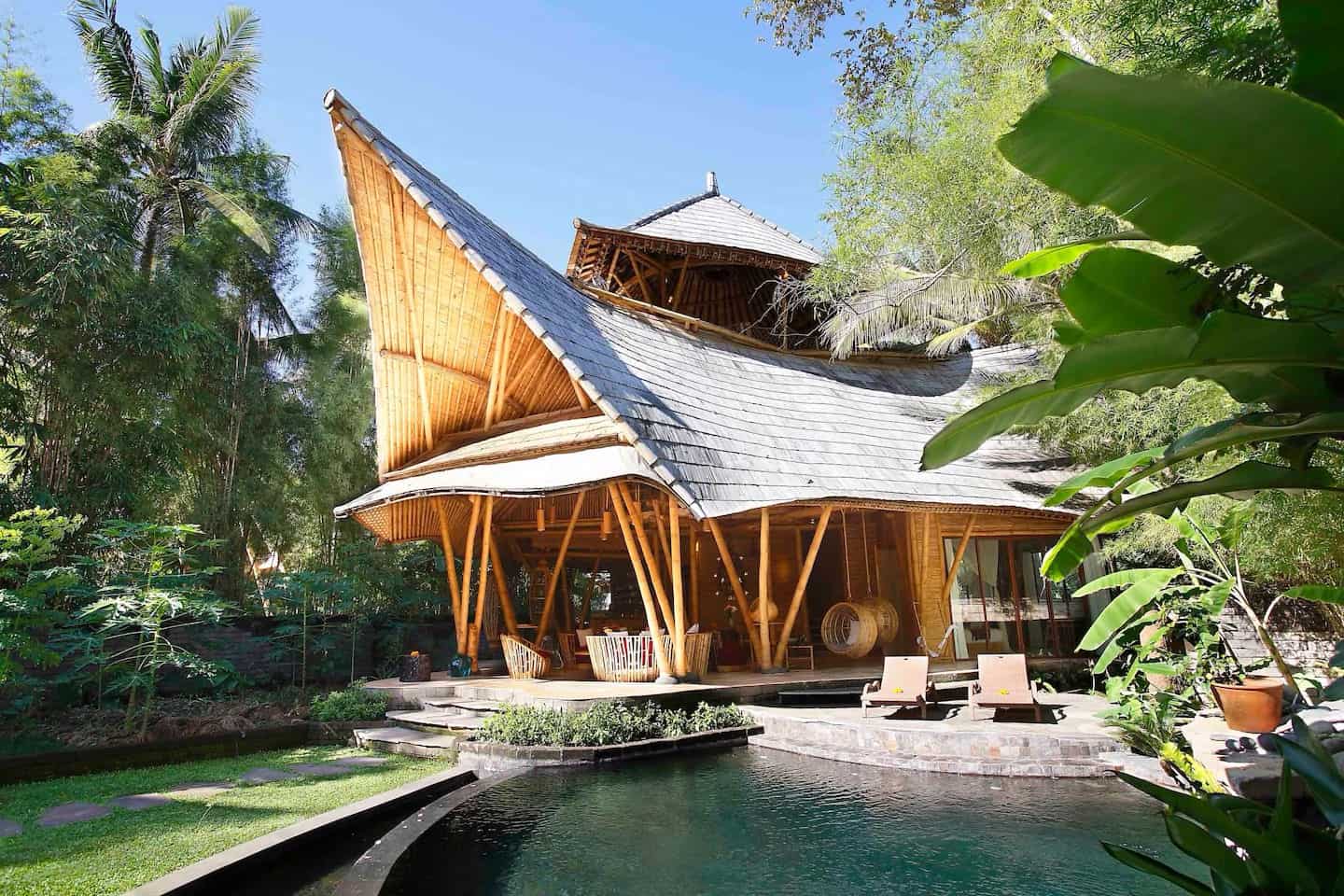
- Sustainable Building Materials: Many eco-friendly villas utilize locally sourced and sustainable materials, such as bamboo, reclaimed wood, and natural stone. These materials not only reduce transportation emissions but also blend seamlessly with the natural surroundings.
- Energy Efficiency: Incorporating energy-efficient technologies, such as solar panels, energy-saving appliances, and passive cooling systems, is a hallmark of sustainable design. These features not only lower energy costs but also contribute to a greener environment.
- Water Conservation: Sustainable villas often include rainwater harvesting systems and greywater recycling, ensuring efficient use of water resources. This commitment to water conservation is especially important in Bali’s tropical climate, where water management is crucial.
- Green Landscaping: Eco-friendly designs often feature native plants and organic gardens, which require less water and maintenance. These landscapes enhance biodiversity and create a harmonious relationship between the villa and its natural surroundings.
And below is the villa with modern design but is using eco friendly technology such as such as solar panels, and water conservation systems like rainwater harvesting.
Unique Fact: Eco-friendly and sustainable villa designs often include biophilic elements, which integrate nature into the living space. Features like green roofs, living walls, and natural ventilation not only improve air quality but also enhance the well-being of residents. This trend reflects a growing awareness of the importance of sustainability in architecture and living, making these villas a perfect choice for environmentally conscious buyers seeking a luxurious yet responsible lifestyle in Bali.
Conclusion
Bali’s diverse villa design trends offer something for everyone, from the traditional charm of Balinese architecture to the sleek elegance of contemporary luxury and the serene simplicity of Japandi style. As the demand for unique and inspiring living spaces grows, potential homeowners can find a wide range of styles that reflect both personal taste and the enchanting environment of the island.
Whether you’re a foreigner looking to build your dream villa or seeking a beautiful property to purchase, Bali’s real estate market presents numerous opportunities to invest in stunning properties. For those interested in exploring these options further, partnering with a reputable real estate agency in Bali can provide invaluable insights and support throughout the buying process.
Embrace the opportunity to create your perfect sanctuary in this tropical paradise, where every villa tells a story of beauty, culture, and sustainable living.


